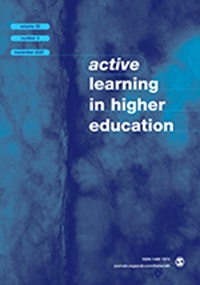Case-based learning and photovoice in relation to academic performance, satisfaction and self-efficacy in higher education: A cross-sectional study of related samples
IF 3.8
1区 教育学
Q1 EDUCATION & EDUCATIONAL RESEARCH
引用次数: 0
Abstract
Photovoice (PV) is an innovative learning methodology that is gaining relevance in higher education, but research about it is still scarce. Case-based Learning (CBL), for its part, has proven to generate a higher level of student engagement and significant learning. Therefore, due to the lack of evidence related to PV learning, the main aim of this study is to analyse and compare a CBL activity and a PV activity regarding academic performance and undergraduate students’ satisfaction in relation to self-efficacy perception. A cross-sectional study was developed. A total of 107 students did a CBL and a PV activity. The order of the activities was randomised. The collected variables were activity score, satisfaction with each activity and self-efficacy perception. A descriptive, correlational and comparative analysis using T-Student of related samples was performed. The results showed a significant difference in the activities’ scores, with higher marks in the PV activity. There was a good level of satisfaction with both activities and no significant differences across all items asked, except for ‘It encouraged new knowledge acquisition’. This item was evaluated more favourably in the CBL activity. The relation between the marks of both activities and self-efficacy perception were not significant but in the case of PV, the mark is almost significant. In conclusion, CBL and PV activities are effective in order to achieve a good academic performance and the students ‘satisfaction with the activities assessed is high.基于案例的学习和摄影作品与高等教育中的学习成绩、满意度和自我效能感的关系:相关样本的横断面研究
摄影自述(PV)是一种创新的学习方法,在高等教育中的相关性越来越大,但有关它的研究仍然很少。事实证明,基于案例的学习(CBL)能提高学生的参与度和学习效果。因此,由于缺乏与光伏学习相关的证据,本研究的主要目的是分析和比较 CBL 活动和光伏活动在学业成绩和本科生自我效能感方面的满意度。我们开展了一项横向研究。共有 107 名学生参加了 CBL 和 PV 活动。活动的顺序是随机的。收集的变量包括活动得分、对每个活动的满意度和自我效能感。使用 T-Student 对相关样本进行了描述性、相关性和比较分析。结果表明,活动得分存在明显差异,光伏活动得分较高。除了 "它鼓励了新知识的获取 "这一项外,学生对这两项活动的满意度都很高,而且在所有提问项目中都没有明显差异。CBL 活动对该项目的评价较高。两项活动的分数与自我效能感之间的关系并不显著,但在自学能力活动中,分数几乎是显著的。总之,CBL 和 PV 活动对取得良好的学习成绩是有效的,学生对活动的满意度也很高。
本文章由计算机程序翻译,如有差异,请以英文原文为准。
求助全文
约1分钟内获得全文
求助全文
来源期刊

Active Learning in Higher Education
EDUCATION & EDUCATIONAL RESEARCH-
CiteScore
13.20
自引率
12.00%
发文量
31
期刊介绍:
Active Learning in Higher Education is an international, refereed publication for all those who teach and support learning in higher education (HE) and those who undertake or use research into effective learning, teaching and assessment in universities and colleges. The journal is devoted to publishing accounts of research covering all aspects of learning and teaching concerning adults in higher education. Non-discipline specific and non-context/country specific in nature, it comprises accounts of research across all areas of the curriculum; accounts which are relevant to faculty and others involved in learning and teaching in all disciplines, in all countries.
 求助内容:
求助内容: 应助结果提醒方式:
应助结果提醒方式:


